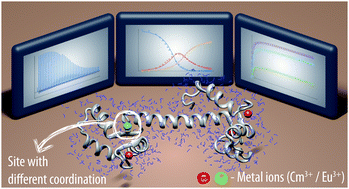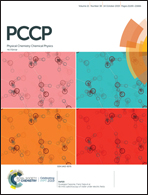Cm3+/Eu3+ induced structural, mechanistic and functional implications for calmodulin†
Abstract
Trivalent actinides and their lanthanide homologues are being scrutinized for their potential health risk when ingested as a result of a range of industrial activities such as mining. Importantly, these ions are known to exhibit high affinity towards calmodulin (CaM). In case of their inadvertent uptake, the holoproteins that are occupied by these cations may block signal transduction pathways or increase the concentration of these ions in intact cells, which could lead to accumulation in human organs. Accordingly, this investigation employed spectroscopy, computational chemistry, calorimetry, and biochemistry to study the results of metal ion substitution on the protein structure, enzymatic activity and chemo- and cytotoxicity of An3+/Ln3+ ions. As will be demonstrated herein, our data confirm the higher affinity of Cm3+ and Eu3+ compared to Ca2+ to all 4 binding sites of CaM, with one site differing from the remaining three. This higher-affinity site will complex Eu3+ in an exothermic fashion; in contrast, ion binding to the three lower-affinity EF-hands was found to be endothermic. The overall endothermic binding process is ascribed to the loss of the hydration shells of the trivalent ions upon protein binding. These findings are supported by extensive quantum chemical calculations of full holo-CaM, which were performed at the MP2 level using the fragment molecular orbital method. The exceptional binding site (EF-hand 3) features fewer negatively charged residues compared to the other EF-hands, thereby allowing Eu3+ and Cm3+ to carry one or two additional waters compared to Ca2+-CaM, while also causing the structure of Cm3+/Eu3+-CaM to become slightly disordered. Moreover, the enzymatic activity decreases somewhat in comparison to Ca2+-CaM. By utilizing a combination of techniques, we were able to generate a comprehensive picture of the CaM-actinide/lanthanide system from the molecular level to its functional impact. Such knowledge could also be applied to other metal-binding proteins.

- This article is part of the themed collection: 2019 PCCP HOT Articles


 Please wait while we load your content...
Please wait while we load your content...